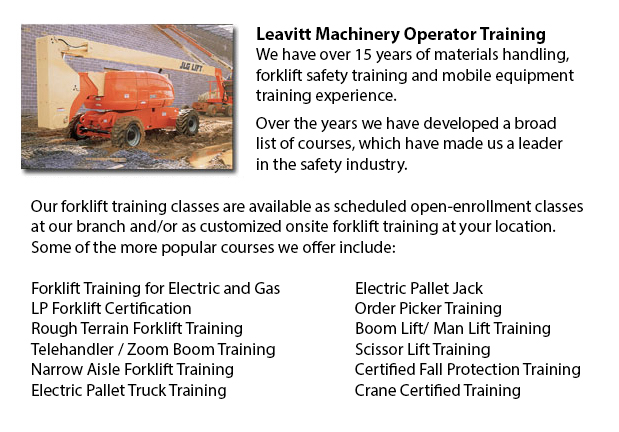
Aerial Lift Safety Training Red Deer - There are approximately 26 to 30 construction fatalities in North America attributed to the utilization of aerial lifts. Nearly all of those killed are craftsmen like for example painters, electrical workers, laborers, carpenters or ironworkers. Nearly all deaths are caused by falls, tip-overs and electrocutions. The greatest risk is from boom-supported lifts, like cherry pickers and bucket trucks. Most fatalities are related to this particular type of lift, with the rest involving scissor lifts. Other hazards include being thrown out of a bucket, being struck by falling things, and being caught between the lift bucket or guardrail and an object, like a joist or steel beam.
The safe operation of an aerial lift needs a check on the following items before using the device: emergency and operating controls, safety devices, personal fall protection gear, and wheels and tires. Inspect for possible leaks in the air, hydraulic fluid and fuel-system. Check the device for loose or missing components.
The area where the device would be used must be carefully inspected for possible dangers, like for instance bumps, holes, drop-offs and debris. Overhead power lines should be avoided or closely monitored. It is suggested that aerial lift devices be utilized on level, stable surfaces. Don't work on steep slopes that go beyond slope restrictions specified by the manufacturer. Even on a slope that is level, outriggers, brakes and wheel chocks must be set.
Employers are needed to provide maintenance mechanics and aerial lift operators with the proper instruction manuals. Mechanics and operators must be trained by a qualified individual experienced with the applicable type of aerial lift.
Aerial Lift Safety Guidelines:
o Close doors or lift platform chains before operating.
o Climbing on and leaning over guardrails is prohibited. Stand on the platform or floor of the bucket.
o Utilize the provided manufacturer's load-capacity restrictions.
o Utilize work-zone warnings, like for instance signs and cones, when working near traffic.
Electrocutions are avoidable if safety procedures are followed. Stay as far away from power lines - at least 10 feet. Trained electrical workers should insulate and/or de-energize power lines. Workers must use personal protective tools and equipment, like for example a bucket which is insulated. However, an insulated bucket does not protect from electrocution if, for instance, the worker touches another wire providing a path to the ground.
When inside the bucket, workers need to prevent possible falls by securing themselves to the guardrails by making use of a positioning device or a full-body harness. If there is an anchorage in the bucket, a positioning belt with a short lanyard is acceptable.
By following the manufacturer's directions, tip-overs can be prevented. Never drive the lift platform when it is elevated, unless otherwise specified by the manufacturer. Follow the horizontal and vertical reach restrictions of the device, and never exceed the specified load-capacity.
-
Fall Protection Ticket Red Deer
Fall Protection Ticket Red Deer - The number one reason of death in the construction industry come from fall-related incidents. There is more possibility for fall accidents depending upon the kinds of work being done in your workplace. Therefore, kno... More -
Overhead Crane Certification Red Deer
Overhead Crane Certification Red Deer - The overhead crane certification course is a course that is designed to help trainees, even if they have language or literacy limitations. The course comprises a practical hands-on training session and a classr... More -
Wheel and Track Loader Training in Red Deer
Lift trucks are obtainable in a variety of various models which have various load capacities. Nearly all typical lift trucks utilized in warehouse settings have load capacities of 1-5 tons. Bigger scale models are utilized for heavier loads, like for... More -
Heavy Equipment Certification Red Deer
Heavy Equipment Certification Red Deer - Heavy duty vehicles are big pieces of machines which are usually known as heavy equipment. It is a broad term that literally includes whatever big utility vehicle in the area of agricultural and forestry imple... More -
Heavy Equipment Operator Classes Red Deer
Heavy Equipment Operator Classes Red Deer - A person who has the correct training to be able to use a particular kind or piece of machine is referred to as an equipment operator. There are different ways that an equipment operator can become trained... More -
Forklift Training Programs Red Deer
Forklift Training Programs Red Deer - Are you searching for a job as a driver of a forklift? Our regulatory-compliant mobile equipment operator training offers instruction in kinds of lift trucks, pre-shift check, fuel types and dealing with fuels, a... More -
Crane Safety Training Red Deer
Crane Safety Training Red Deer - Both crane driver and their supervisors must know all the potential problems related to the operation of an overhead crane. All over North America, there is legislation which provides rules for the safe inspection, ma... More -
Aerial Lift Training Red Deer
Aerial Lift Training Red Deer - An aerial work platform is a mechanized access platform. This device provides access to otherwise inaccessible places for people or equipment. Likewise called an elevating work platform or aerial device, the machinery... More

Forklift Training Red Deer
TOLL FREE: 1-888-254-6157
Red Deer, Alberta
forklifttrainingreddeer.com
Email Us
About Us


